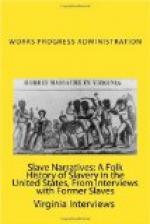II
Set beside the work of formal historians, social scientists, and novelists, slave autobiographies, and contemporary records of abolitionists and planters, these life histories, taken down as far as possible in the narrators’ words, constitute an invaluable body of unconscious evidence or indirect source material, which scholars and writers dealing with the South, especially social psychologists and cultural anthropologists, cannot afford to reckon without. For the first and the last time, a large number of surviving slaves (many of whom have since died) have been permitted to tell their own story, in their own way. In spite of obvious limitations—bias and fallibility of both informants and interviewers, the use of leading questions, unskilled techniques, and insufficient controls and checks—this saga must remain the most authentic and colorful source of our knowledge of the lives and thoughts of thousands of slaves, of their attitudes toward one another, toward their masters, mistresses, and overseers, toward poor whites, North and South, the Civil War, Emancipation, Reconstruction, religion, education, and virtually every phase of Negro life in the South.
The narratives belong to folk history—history recovered from the memories and lips of participants or eye-witnesses, who mingle group with individual experience and both with observation, hearsay, and tradition. Whether the narrators relate what they actually saw and thought and felt, what they imagine, or what they have thought and felt about slavery since, now we know why they thought and felt as they did. To the white myth of slavery must be added the slaves’ own folklore and folk-say of slavery. The patterns they reveal are folk and regional patterns—the patterns of field hand, house and body servant, and artisan; the patterns of kind and cruel master or mistress; the patterns of Southeast and Southwest, lowland and upland, tidewater and inland, smaller and larger plantations, and racial mixture (including Creole and Indian).
The narratives belong also to folk literature. Rich not only in folk songs, folk tales, and folk speech but also in folk humor and poetry, crude or skilful in dialect, uneven in tone and treatment, they constantly reward one with earthy imagery, salty phrase, and sensitive detail. In their unconscious art, exhibited in many a fine and powerful short story, they are a contribution to the realistic writing of the Negro. Beneath all the surface contradictions and exaggerations, the fantasy and flattery, they possess an essential truth and humanity which surpasses as it supplements history and literature.
Washington, D.C.
June 12, 1941
B.A. Botkin
Chief Editor, Writers’ Unit
Library of Congress Project
SELECTED RECORDS Bearing on the History of the Slave Narratives




